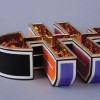The Nikko Transfer Series ceramic sculpture installations stem primarily from a visit I made in 1986 to Nikko National Park, located outside Tokyo, Japan. During my visit to Nikko, I was overwhelmed by one shrine in particular, the Nikko Toshogu Shrine. Its exquisite architectural beauty, typical of the Japanese Edo period, emanates from temples that are a fantasy of brilliant hues of orange, green, blue, black and red, lacquered wood with applications of gold leaf to protect the beautiful carvings from the wind and rain. The visual opulence and color sensations that I experienced during that visit have remained with me.
This sculpture is built by hand using a low-fire, white clay
body. The geometric austerity of the shape is relieved with
colors reminiscent of Nikko Shrine itself. The exterior decoration
of my architectonic sculptural form is executed in pure colors
like those of the shrine. The interior of this piece is embellished
with an opulent 14-carat gold luster, fired at C/019 over
a previously fired C/04 transparent glaze. The installation
of the sculpture inside a Plexiglas case, with its bilateral
symmetry and decorated underside reflected in a mirror, embodies
and enhances the transfer concept, as it exudes a quiet tranquility.
The Nikko Transfer Series: Nikko Transformed sculpture
is a material metaphor that provides a tangible manifestation
of my Nikko experience.
Nikko Transfer Series: Nikko Curvature. Collection of Arizona State University Museum of Art
